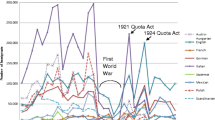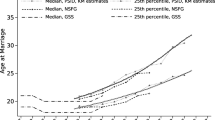Abstract
Women's labor force participation, ethnic status and interracial marriage are examined in this paper to test Grossbard-Shechtman's marriage market theory. Perceived racial and ethnic group status is found to be an important attribute in marriage market exchange that combines marriage and working outside the home. Caucasian women, who have a higher perceived ethnic status, tend not to work when they marry men of a lower perceived ethnic status, while the opposite is found of women who have a lower perceived group status and who marry into a higher-status group. This is especially of women with low education, while highly educated women are less affected by compensating differentials at marriage as related to ethnic status of the couple. Ethnic groups that have a recent immigration history also have a different pattern of intermarriage and women's labor force participation.
Similar content being viewed by others
References cited
Adams, Romanzo C. 1969. Interracial marriage in Hawaii; a study of the mutually conditioned processes of acculturation and amalgamation. Patterson Smith, 1969 [c1937], Montclair, New Jersey.
Apps, Patricia. 1981. A theory of inequality and taxation. Cambridge University Press, Cambridge.
Barnett, Larry D. 1962. Research in interreligious dating marriage. Marriage and Family Living 24:191–94.
Becker, Gary. 1965. A theory of the allocation of time. Economic Journal 75:493–515.
Becker, Gary. 1973. A theory of marriage: Part I. Journal of Political Economy 81:813–846.
Becker, Gary. 1981. A treatise on the family. Harvard University Press, 1981.
Bergstrom, Theodore C. 1997. A survey of theories of the family. In Rosenzweig, Mark & Oded Stark, Handbook of population and family economics. Northholland-Elsevier, New York.
Blau, Peter M. 1964. Exchange and power in social life. John Wiley, New York.
Blau, Peter M. 1977. Inequality and heterogeneity. Free Press, New York.
Blau, Peter M., T. C. Blum & J. E. Schwartz. 1982. Heterogeneity and intermarriage. American Sociological Review 47:45–62.
Blau, Peter M. & Joseph E. Schwartz. 1984. Cross-cutting social circles: testing a macrostructural theory of intergroup relations. Academic Press, New York.
Blau, Peter M., Carolyn Beeker & Kevin M. Fitzpatrick. 1984. Intersecting social affiliations and intermarriage. Social Forces 62:585–605.
Boissevain, Jeremy. 1974. Friends of friends: networks, manipulators, and coalitions. Blackwell, Oxford.
Brien, Michael & Michelle Seran. (Forthcoming). The economics of marriage and household formation. In Marriage and the Economy, edited by Shoshana Grossbard-Shechtman. Cambridge University Press, Cambridge and New York.
Browning, Martin, Francois Bourguignon, Pierre-Andre Chiappori & Valerie LeChene. 1994. Incomes and outcomes: a structural model of intrahousehold allocation. Journal of Political Economy 102(6):1067–1096.
Campbell, Angus. 1971. White attitudes toward black people: Institute for Social Research, University of Michigan, Ann Arbor.
Chiappori, Pierre-Andre. 1992. Collective labor supply and welfare. Journal of Political Economy 100:437–467.
Chiswick, Barry. 1988. Labor supply and investment in child quality: a study of Jewish and non-Jewish women. Contemporary Jewry 9:35–61.
Davis, Kingsley. 1941. Intermarriage in caste societies. American Anthropologist 43:376–395.
Edwards, John N. 1969. Familial behavior as social exchange. Journal of Marriage and the Family 31:518–533.
Fu, Xuanning, & Tim B. Heaton. 1997. Interracial marriage in Hawaii: 1983–1994. The Edwin Mellen Press, Lewiston, New York.
Gronau, Reuben. 1977. Leisure, home production, and work—the theory of the allocation of time revisited. Journal of Political Economy. 85:1099–1124.
Gronau, Reuben. 1981. Wives' labor force participation, wage differentials, and family income inequality: the Israeli experience. Working Paper 668. NBER, Cambridge, Mass.
Grossbard-Shechtman, Amyra. 1984. A theory of allocation of time in markets for labour and marriage. Economic Journal 94(December):863–882.
Grossbard-Shechtman, Shoshana A. 1993. On the economics of marriage. Westview Press, Boulder.
Grossbard-Shechtman, Shoshana A 2001. A model of labor supply and marriage. Paper presented at the annual meetings of the American Economic Association in New Orleans (January).
Grossbard-Shechtman, Shoshana A. (ed.) (Forthcoming). Marriage and the Economy. Cambridge University Press, Cambridge and New York.
Grossbard-Shechtman, Shoshana & Clive W.J. Granger. 1998. Women's jobs and marriage: baby-boom or baby bust. Population, 53:731–752 (in French).
Grossbard-Shechtman, Shoshana A. & Matthew Neideffer 1997. Women's hours of work and marriage market imbalances. In Economics of the Family and Family Policies, edited by Inga Persson & Christina Jonung, Routledge, London.
Grossbard-Shechtman, Shoshana A. & Shoshana Neuman. 1988. Labor supply and marital choice. Journal of Political Economy 96(December): 1294–1302.
Grossbard-Shechtman, Shoshana A. & Shoshana Neuman. 1998. The extra burden of Moslem wives: clues from Israeli women's labor supply. Economic Development and Cultural Change, 46(April):491–518.
Gurak, Douglas T. & Joseph P. Fitzpatrick. 1982. Intermarriage among Hispanic ethnic groups in New York City. American Journal of Sociology 87:921–934.
Heaton, Tim B. 1990. Religious groups characteristics, endogamy, and interfaith marriages. Review of Religious Research 51:363–376.
Heckman, James. 1974. Shadow prices, market wages and labor supply. Econometrica 42:679–94.
Heer, David M. 1962. The trend of interfaith marriages in Canada: 1922–1957. American Sociological Review 27:245–250.
Heer, David M. 1966. Negro-white marriage in the United States. Journal of Marriage and the Family 80:262–273.
Heer, David M. 1974. The prevalence of Black-white marriage in the U.S., 1960 and 1970. Journal of Marriage and the Family 36:246–58.
Hersch, Joni. 1997. The economics of home production. Southern California Review of Law and Women's Studies 6:421–440.
Hollingshead, August B. 1950. Cultural factors in the selection of marriage mates. American Sociological Review 15:619–627.
HSMDH. 1995. Office of Health Monitoring, Department of Health, State of Hawaii. Marriage certificate data compilation file, 1983–1994.
Jackson, R. M., Claude S. Fischer & J. M. Jones. 1977. The dimensions of social networks. In Claude S. Fischer (Ed.), Networks and Places: Social Relations in the Urban Setting. Free Press, New York.
Kalmijn, Matthijs. 1993. Trends in Black/white intermarriage. Social Forces 72:119–146.
Labov, Teresa & Jerry A. Jacobs. 1986. Intermarriage in Hawaii, 1950–1983. Journal of Marriage and the Family 48(February):79–88.
Lehrer, Evelyn L. 1995. The effects of religion on the labor supply of married women. Social Science Research 24:281–301.
Lehrer, Evelyn L. (Forthcoming). The economics of divorce. In Marriage and the Economy, edited by Shoshana Grossbard-Shechtman. Cambridge University Press, Cambridge and New York.
Lundberg, Shelly & Robert A. Pollak. 1993. Separate sphere bargaining and the marriage market. Journal of Political Economy 101:988–1010.
Manser, Marilyn & Murray Brown. 1980. Marriage and household decision making: a bargaining analysis. International Economic Review 21:31–44.
McElroy, Marjorie B. & Mary Jane Horney. 1981. Nash bargained household decisions: toward a generalization of the theory of demand. International Economic Review 22:31–44.
Merton, Robert K. 1941. Intermarriage and the social structure. Psychiatry 4:361–374.
Mincer, Jacob. 1962. Labor force participation of married women: a study of labor supply. In Aspects of labor economics, edited by H. Gregg Lewis. Princeton University Press, Princeton, N.J.
Oppenheimer, Valerie K. 1994. Women's rising employment and the future of the family in industrial society. Population and Development Review 20(June):293–342.
Parkman, Margaret A. & Jack Sawyer. 1967. Dimensions of ethnic intermarriage in Hawaii. American Sociological Review 32:593–607.
Robbins, Lionel. 1930. On the elasticity of demand for income in terms of efforts. Economica 10:123–129.
Rosenthal, Erich. 1963. Studies of Jewish intermarriage in the United States. American Jewish Yearbook 64:3–53.
Ridley, Carl A. & Arthur W. Avery. 1979. Social network influence on the dyadic relationship. In Robert L. Burgess & Ted L. Huston (eds.), Social exchange in developing relationships. Academic Press, New York.
Robbins, Lionel. 1930. On the elasticity of demand for income in terms of efforts. Economica 10:123–129.
Schoen, Robert. 1986. A methodological analysis of intergroup marriage. Sociological Methodology 16:49–78.
Schoen, Robert & John Wooldredge. 1989. Marriage choices in North Carolina and Virginia, 1969–71 and 1979–81. Journal of Marriage and the Family 51:465–481.
Spickard, Paul R. 1989. Mixed blood: intermarriage and ethnic identity in twentieth-century America. University of Wisconsin Press, Madison, WI.
Thomas, John L. 1972. The factor of religion in the selection of marriage mates. In M. L. Barron (Ed.), The blending American: patterns of intermarriage. Quadrangle Books, Chicago.
Treiman, Donald J. 1977. Occupational prestige in comparative perspective. Academic Press, New York.
Tucker, M. Belinda & Claudia Mitchell-Kernan. 1990. New trends in black American interracial marriage: the social structural context. Journal of Marriage and the Family 52:209–218.
Wallace, Ruth A. & Allison Wolf. 1991. Contemporary sociological theory—continuing the classical tradition. 3rd Edition, Prentice Hall, Englewood Cliffs, NJ.
Woolley, Frances. 1988. A non-cooperative model of family decision making. Working paper # 125. London School of Economics, London.
Woolley, Frances. (Forthcoming). Control over money in marriage. In Grossbard-Shechtman (ed.) Marriage and the Economy. Cambridge University Press, Cambridge and New York.
Author information
Authors and Affiliations
Rights and permissions
About this article
Cite this article
Grossbard-Shechtman, S., Fu, X. Women's Labor Force Participation and Status Exchange in Intermarriage: A Model and Evidence for Hawaii1 . Journal of Bioeconomics 4, 241–268 (2002). https://doi.org/10.1023/A:1021776126532
Issue Date:
DOI: https://doi.org/10.1023/A:1021776126532




